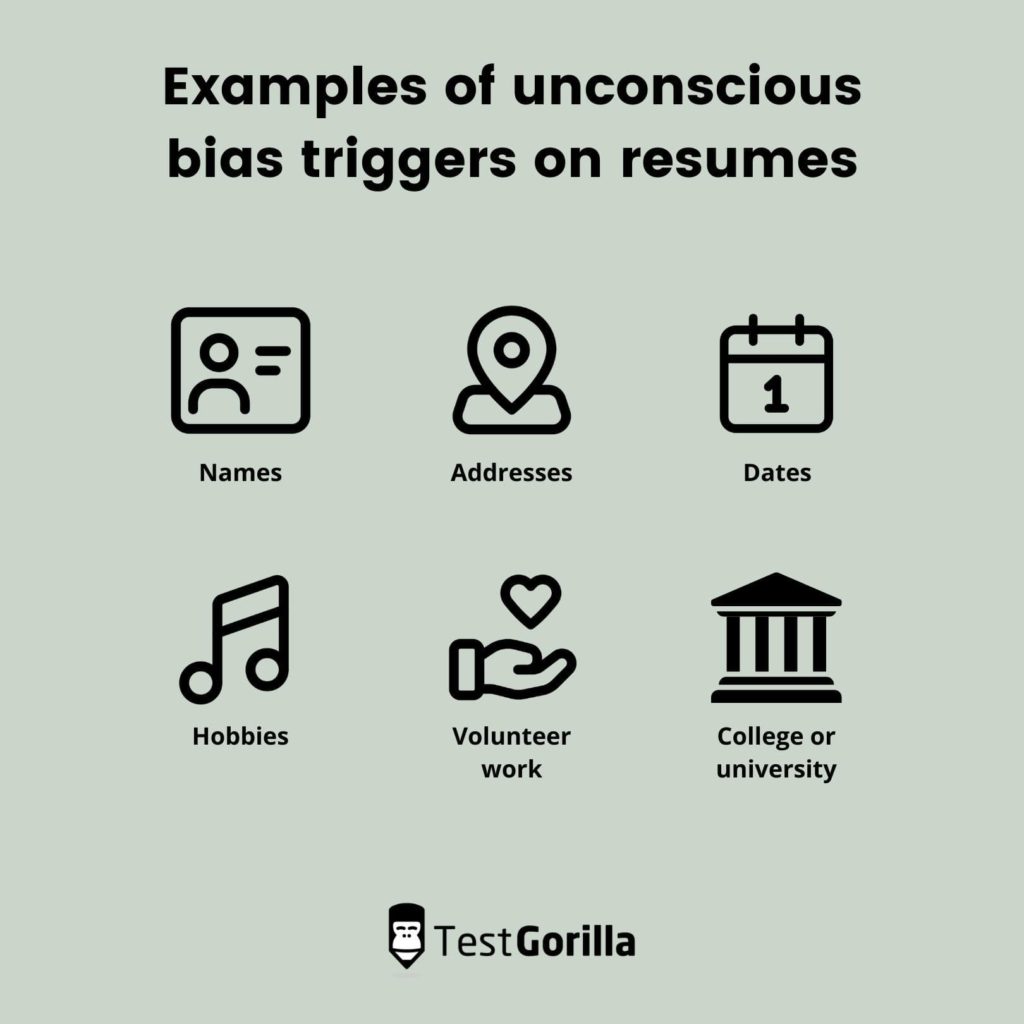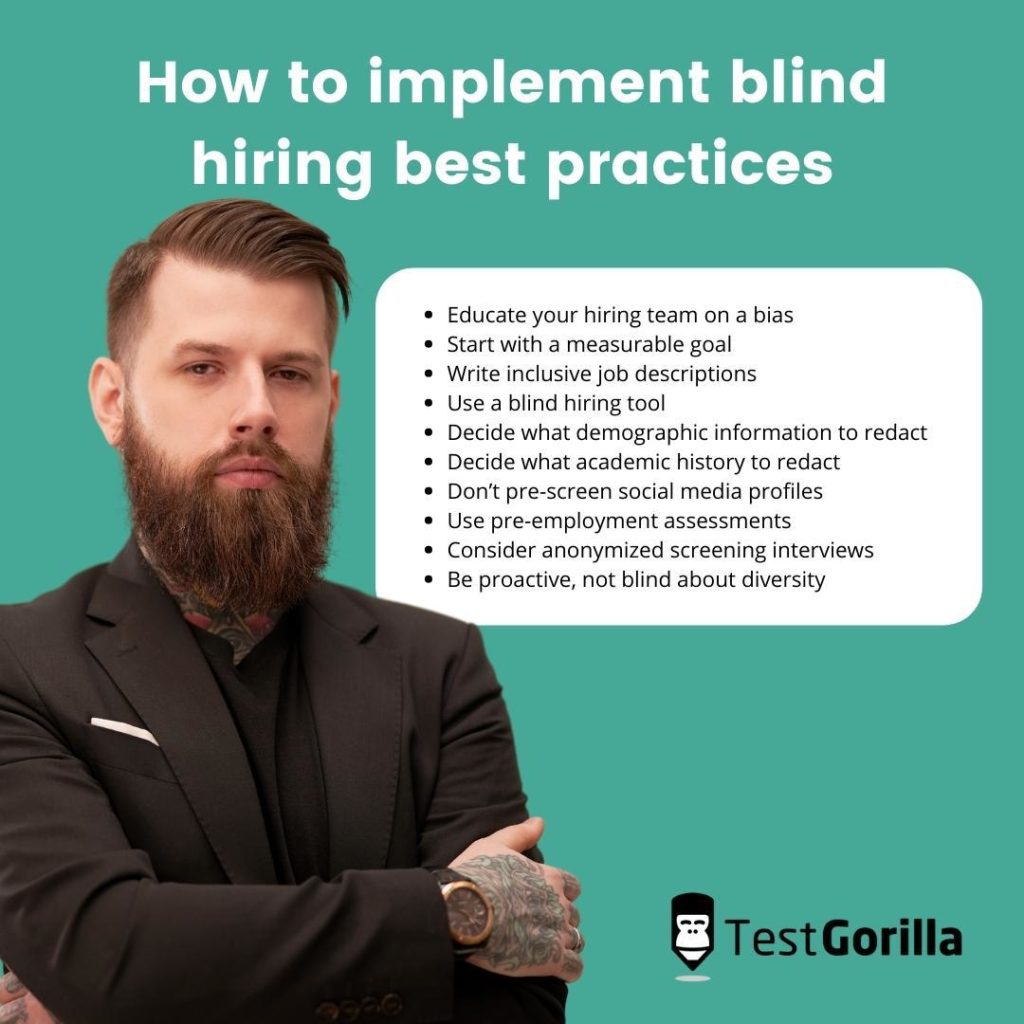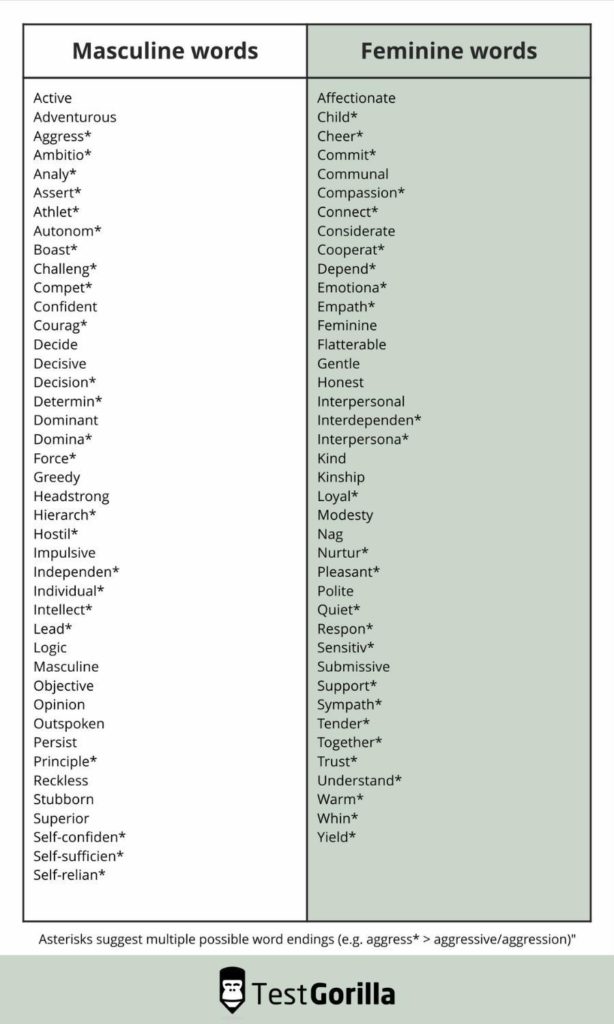Blind hiring: Can candidate anonymity reduce hiring bias?
If you’ve ever seen the TV show The Voice, blind hiring is the same premise.
On The Voice, singers perform a blind audition while the judges have their backs to the performer. Since the judges can’t see the singer, they can only pick singers based on their talent.
In contrast, in other singing talent competitions such as American Idol or America’s Got Talent, the contestant is judged on their “whole package.” If you want to sell lots of albums to teenagers, this could be the way to go. However, if you aim to put together the best possible team of vocalists, the blind audition technique yields more raw talent.
Blind hiring uses the same principle as blind recruiting. You look only at the aspects of a candidate that matter and ignore the things that don’t.
The question is, does blind hiring work? Or are there better alternatives to hiring without bias?
In this article, we’ll argue that blind recruitment is simply one component of a well-rounded diversity hiring strategy that also involves pre-employment assessments and a proactive approach to team diversity.
Table of contents
What is blind hiring?
Blind hiring is the practice of redacting any personal, demographic, or unnecessary professional information throughout the recruiting process to reduce recruiter bias.
Most blind hiring practices occur at the screening stage when recruiters remove names, dates, addresses, interests, schools, and other information from candidate resumes.
Some organizations will conduct blind interviews through chat, but even the most blind hiring procedures will inevitably lead to face-to-face interviews.
The goal of blind hiring is to concentrate on a candidate’s skills rather than their personality and to focus on what they can offer your team today rather than what they’ve done in the past.
How do unconscious biases impact recruitment?
HR departments are focusing on reducing bias in the hiring process to foster a more intentional approach to workplace diversity. That’s because the list of benefits of workplace diversity is extensive and well-supported by research.
Diverse businesses, for example, are more financially successful.
According to a 2015 McKinsey study, companies in the top quartile for racial and ethnic diversity are 35% more likely to earn above-median profits than their industry. Likewise, companies in the top quartile for gender diversity are 15% more likely to generate above-median profits. On the other hand, companies in the bottom quartile made less than the median profit.
Diverse companies are also more innovative. For example, a 2018 study from NC State revealed a relationship between ethnic, gender and sexual diversity and the number of product launches at U.S. companies.
Unfortunately, even the best-intentioned can fall victim to unconscious biases at various stages of the hiring process.
Candidate resumes, in particular, serve as a trigger of unconscious biases in recruiters. Here are a few examples.
Names
The most crucial predictor of a candidate’s race is their name. A 2003 study conducted by the National Bureau of Economic Research in Boston and Chicago found that candidates with White-sounding names (e.g., Emily and Greg) were 50% more likely to receive interview callbacks in comparison to candidates with African-American-sounding names (e.g., Lakisha and Jamal)—even when their resumes were identical.
The concept of “resume whitening” was investigated in a 2016 study conducted by the University of Toronto. Asian-American candidates, for example, often use their “English” nicknames rather than their birth names. According to their research, non-White candidates with “whitened” resumes received more interview callbacks than non-whitened resumes.
Names are also an indicator of gender, another well-documented cause of prejudice, particularly in STEM fields. For example, a 2014 study from Columbia University found that men were twice as likely as women to get hired for science positions.
Addresses
Addresses can also be used to determine wealth or class, and thus, race. The same 2003 National Bureau of Economic Research study found that applicants in better neighborhoods received 30% more interview callbacks.
Dates
Recruiters may use dates for professional or educational milestones to estimate a candidate’s age. This can result in ageism bias, in which older candidates are passed over for younger candidates. Dates can also reveal time gaps between jobs, leading to unintended discrimination against parents—especially mothers.
Hobbies or volunteer work
Candidates include their interests to show off a bit of their individuality. This can, however, reveal their age, parenting status, or religious affiliation. In addition, hobbies can sometimes cause similarity biases, in which recruiters unintentionally favor candidates who are similar to them.
Name of college or university
Hiring managers may be prejudiced against non-Ivy-League schools or rival schools to their own. Some universities, such as historically black colleges and universities in the U.S, may also signify race.
Does blind hiring improve workplace diversity?
Most companies use blind hiring practices to minimize hiring bias and increase workplace diversity—but does it work?
The most frequently cited example of blind hiring in action was the change in hiring practices from symphony orchestras across the U.S. in the 1970s and ‘80s. Most big orchestras used blind auditions to address the male bias that afflicted orchestras in the 1950s and 1960s (just like The Voice).
As a consequence of introducing blind auditions, female players in the five highest-ranking orchestras increased from 6% in 1970 to 21% in 1993. This has long been seen as a victory for blind hiring.
However, recent critics have pointed out that American orchestras are still majorly lacking in diversity—just 1.85% of players are Black, and only 2.5% of players are Latino.
These critics claim that blind hiring ignores the more significant barriers racial or gender minority applicants may have faced to achieve equal talent compared to their more privileged peers. Moreover, they contend that the auditioners at elite orchestras are practically indistinguishable in terms of talent, implying that blind auditions are akin to drawing names at random from a hat.
These blind auditions turn a blind eye to recruiting for diversity, leaving the composition of their teams entirely up to chance.
If orchestras used blind auditions to pick a larger pool of top candidates and then deliberately selected a diverse team from that pool, they would gain all of the benefits mentioned of a varied team without sacrificing any talent.
What should hiring teams take away from this?
Blind hiring alone won’t improve your team’s diversity. It can be used to prevent underestimating or overvaluing applicants for the wrong reasons throughout the screening process, but to develop a diverse workforce, you must be proactive and purposeful.
How to implement blind hiring best practices
What does blind hiring look like in practice?
Here are some practical steps you can take to remove unnecessary candidate information and boost your diversity hiring efforts.
1. Educate your hiring team on a bias
The most crucial aspect of blind hiring to remember is that the biases you’re attempting to overcome exist within your recruiting team.
We inherit biases from our environment and our upbringing, but through education, we may overcome them. Making your team aware of their possible unconscious biases without being accusatory might result in a more inclusive recruiting and a more “blind” hiring process overall.
2. Start with a measurable goal
Any diversity hiring strategy should begin with a quantifiable goal. Although implementing blind recruiting will require a significant amount of effort, you must ensure that it has a measurable impact.
Are you trying to hire more women? Are you attempting to diversify your team’s racial diversity? Do you want to hire people from a broader range of countries? Are you trying to recruit more candidates with disabilities?
Aim for a specific percentage increase in one or more of these areas. “Hire 20% more women,” for example. A measurable goal will help you to determine whether or not your blind hiring initiative was a success.
3. Write inclusive job descriptions
Writing inclusive job descriptions isn’t always a blind hiring practice, but it’s still a necessary step towards minimizing hiring bias and achieving your diversity goals.
Gendered language, for example, can deter women from applying to available positions. A 2011 APA study found that female candidates viewed job advertisements that utilized terms associated with masculine stereotypes (e.g., competitive, dominating, leader) as less attractive.
In contrast, words linked with feminine stereotypes (e.g., support, comprehend, interpersonal) did not diminish male applicants’ interest. As a result, the authors found that gendered language maintained gender disparity in a male-dominated industry.
So how prevalent is gendered language in job descriptions?
As per the 2016 ZipRecruiter study, 70% of job postings in the U.S. featured masculine words. They also discovered that job postings in male-stereotyped industries featured more gendered language. More than 90% of job advertisements in business, science and engineering, technology, and finance contained gendered terms.
Fortunately, eliminating these gendered terms has a discernible effect. For example, ZipRecruiter found that job postings with gender-neutral language received 42% more applications.
Audit your job descriptions for gendered language. For example:
Male-gendered: We’re looking for a self-reliant competitor to fuel our aggressive growth.
Female-gendered: We’re looking for an honest, dependable candidate to nurture our team’s growth.
Neutral-gendered: We’re looking for a highly motivated, hard-working candidate to add to our exceptional team.
Gender Decoder can assist you in detecting gender-biased language in your job postings.
You can also make your job descriptions more inclusive by emphasizing required abilities rather than stating a minimum or the maximum number of years’ experience or mentioning desired personality traits.
Including a diversity and inclusion statement in your job postings also demonstrates your commitment to unbiased hiring.
4. Use a blind hiring tool
Before you decide what personal information you’ll redact from candidate applications, you’ll need a rock-solid strategy in place for how you’re going to make it happen.
While blind hiring can be accomplished manually using a good-old-fashioned sharpie, using a software solution to anonymize the recruiting process is considerably easier.
Some applicant tracking systems or resume screening tools provide blind recruiting capabilities that conceal names and emails until the interview process.
There are also blind talent matching systems that will assess candidates’ skills and compare them with companies with diverse hiring goals.
Finally, pre-employment assessments, while not outright blind hiring tools, will assist you in testing candidates on their key competencies to select the best candidate for the role.
5. Decide what demographic information to redact
Redacting applicant names is essential for blind recruiting. Redacting names also entails redacting emails, social handles, and website URLs, as they all often include candidate names.
It’s also a good idea to eliminate locations that might cause prejudice, such as birth cities or home addresses. However, it’s rarely relevant to the job.
You may also choose to exclude specific years. For example, it’s crucial to know how long a candidate worked in each of their roles to get a sense of their experience, but it’s irrelevant to know what year they graduated school or how long of a gap they had between employment. All of these are causes of bias that have little influence on performance.
6. Decide what academic history to redact
Redacting academic history is a more challenging choice. Recruiters will have unconscious (or occasionally conscious) bias towards specific schools. Therefore, it’s better to keep the candidate’s school hidden in most situations.
If you conceal a candidate’s school, you should also hide their GPA. GPAs create hiring biases since a good GPA from an easy school is regarded more favorably than a low GPA from a stricter school, and therefore can’t be assessed in isolation.
Assuming you also eliminate years of education, all that’s left is the degree and field of study. If a relevant degree is required for succeeding in the role, you should leave both the degree and specialization. However, if your only goal is to ensure that they achieved a post-secondary education, you could also choose to redact their study subject.
7. Don’t pre-screen social media profiles
If you don’t know a candidate’s name, it’ll be nearly impossible to find a candidate’s social profile, but it should be noted anyway: screening a candidate’s social profile is a potential source of bias.
Wait to screen applicants’ social media pages for red flags until you’ve interviewed them. Even when you’re doing so, don’t use their social media accounts to make judgments about their suitability for the role. Only search for red flags that are opposed to your company’s beliefs.
8. Use pre-employment assessments
Once you’ve removed candidates’ personal information, it’s time to put their skills to the test. As a result, using a pre-employment assessment platform is, therefore, a crucial step in the blind hiring process.
Variety is the spice of life, but it’s also essential to a solid pre-employment assessment. Of all methods for testing and selecting job applicants, research has repeatedly demonstrated that when you align what you measure with what you’re trying to predict, you’ll have the most success with your hiring process. Using different tests that align with different parts of what it means to be successful on the job will lead to the best hires.
As a result, in addition to testing applicants on hard skills like programming knowledge, software proficiency, and role-specific skills (e.g., cybersecurity), you should also evaluate them on soft skills such as cognitive ability, personality, or situational judgment.
Pre-employment assessments work. Research from Aberdeen Group found that employers that conduct pre-employment assessments are 36% more likely to be satisfied with the hires they make compared to those who don’t.
By testing candidates on their skills, you have a viable method for comparing one candidate to another with minimal bias.
9. Consider anonymized screening interviews
Once you’ve identified your top candidates through testing, you may consider anonymizing your initial screening interviews.
For example, you may have anonymous discussions with candidates or send them pre-screening questions via your ATS or a chatbot.
Without a solid blind hiring technology, this may be difficult to pull off without a strong blind hiring tool, but it may help you eliminate recruiter biases before forwarding clients to their final interviews.
10. Be proactive, not blind about diversity
Consider the symphonic orchestra example. After you’ve objectively compared candidates via blind recruiting and pre-employment testing and are sure that your remaining candidates all have the essential capabilities for the position, it’ll be time for face-to-face interviews.
You should remove your blinders at that moment. Strive to select candidates who will add to your culture—rather than simply .fit in with it. Choose candidates who will offer diversity to your team, in whatever form that diversity comes in.
Reduce hiring bias with TestGorilla
When it comes to minimizing hiring prejudice, one tool at your disposal is blind recruitment. However, whether you want to use blind hiring practices or not, a candidate assessment tool will assist you in choosing the best candidates without bias.
Get started with TestGorilla today to explore how pre-employment assessments can help minimize hiring bias in your organization.
Related posts
You've scrolled this far
Why not try TestGorilla for free, and see what happens when you put skills first.
Latest posts
The best advice on pre-employment testing, in your inbox.
No spam. Unsubscribe at any time.

Hire the best. No bias. No stress.
Our screening tests identify the best candidates and make your hiring decisions faster, easier, and bias-free.
Free resources
This checklist covers key features you should look for when choosing a skills testing platform
This resource will help you develop an onboarding checklist for new hires.
How to assess your candidates' attention to detail.
Learn how to get human resources certified through HRCI or SHRM.
Learn how you can improve the level of talent at your company.
Learn how CapitalT reduced hiring bias with online skills assessments.
Learn how to make the resume process more efficient and more effective.
Improve your hiring strategy with these 7 critical recruitment metrics.
Learn how Sukhi decreased time spent reviewing resumes by 83%!
Hire more efficiently with these hacks that 99% of recruiters aren't using.
Make a business case for diversity and inclusion initiatives with this data.




















